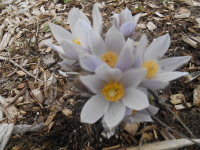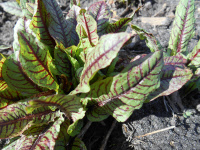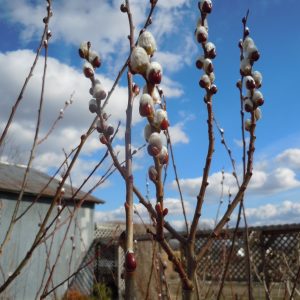Archives
Showing 145–152 of 199 results
-
Pulsatilla patens syn. Anemone patens Eastern pasque flower Z 3-7
Up-facing blue-violet bells in early spring emerge from foliage decorated with silky hairs.
ARCHIVED
Note: This is a plant not currently for sale. This is an archive page preserved for informational use.
Up-facing blue-violet bells in early spring emerge from foliage decorated with silky hairs.
Size: 8-12” x 4-6" slow to grow, so be patient
Care: sun in moist well-drained to well-drained soil
Native: northern Great Plains including WI, Siberia, AlaskaThe name Pasque is Old French for Easter referring to the spring bloom time. Patens means “spreading.” South Dakota honors this as its state flower.
Collected for gardens prior to 1753. The Blackfoot made a decoction of this plant to speed a baby’s delivery and applied crushed leaves to skin to remedy irritation. Omaha applied fresh, crushed leaves as a poltice for rheumatism. -
Pulsatilla vulgaris var. ‘Alba’ Z 4-8
Pure white petals of open bell-shape with yellow centers flowers in early spring. Fun, furry foliage and Medusa-like seed heads.
ARCHIVED
Note: This is a plant not currently for sale. This is an archive page preserved for informational use.
Pure white petals of open bell-shape with yellow centers flowers in early spring. Fun, furry foliage and Medusa-like seed heads.
Size: 8-12” x 8-12”
Care: sun to part shade in well-drained to moist well-drained soil
Native: Europe
Wildlife Value: Deer resistant, early pollen source for bees
Awards: Royal Horticultural Society Award of Garden Merit“There is a variety of (Pulsatilla vulgaris) with white flowers…” Gardeners Dictionary, 1768.
-
Punica granatum var. nana Dwarf pomegranate Z 7-11
Adorable dwarf shrub bearing orange-red blooms in July and August then tiny, edible pomegranates. Where not hardy makes good container plant and bonsai.
ARCHIVED
Note: This is a plant not currently for sale. This is an archive page preserved for informational use.
Adorable dwarf shrub bearing orange-red blooms in July and August then tiny, edible pomegranates. Where not hardy makes good container plant and bonsai.
Size: 2-4’ x 2-4’
Care: sun to part shade in moist well-drained to well-drained soil
Native: Europe to Himalayas“The plants will bear miniature fruit if grown in areas with year-round temperatures that rarely fall below 40° F. To grow indoors, moderate night-time temperatures should be given (50° to 60° F). Keep at 40° to 45° F in winter until new growth appears. In the growing period, keep moderately moist. Water sparingly from August on. This plant requires good drainage. Plants will bear fruit indoors if grown in a sunny exposure.” Issour Botanic Garden. It is deciduous and may lose its leaves.
This dwarf described in 1803. -
Ranunculus acris ‘Flora-pleno’ Meadow buttercup Z 4-8 POISON
Scads of cheerful yellow balls made from many petals, bloom in early spring. Excellent cut flower
ARCHIVED
Note: This is a plant not currently for sale. This is an archive page preserved for informational use.
Scads of cheerful yellow balls made from many petals, bloom in early spring. Excellent cut flower
Size: 18-24” x 12” slowly spreading
Care: Sun to part sun in moist soil
Native: Europe
Wildlife Value: deer resistant, attract butterflies
Awards: Royal Horticultural Society Award of Garden MeritRanunculus is Latin for little frog, so named by Roman Pliny referring to the wet conditions required by some ranunculus. William Robinson considered this “pretty.” The English Flower Garden 1899.
-
Rudbeckia laciniata ‘Herbstsonne’ Rudbeckia nitida ‘Herbstsonne’ syn. Rudbeckia ‘Autumn Sun’ Z 5-10
Exceptionally large & drooping petals, with a tall, central cone of green, blooms July to September.
ARCHIVED
Note: This is a plant not currently for sale. This is an archive page preserved for informational use.
Exceptionally large & drooping petals, with a tall, central cone of green, blooms July to September.
Size: 4-7’ x 2-3’
Care: sun to part shade in moist well-drained soil
Wildlife Value: provides butterfly nectar and seeds food for birds
Awards: Royal Horticultural Society Award of Garden MeritIt’s “an old selection.”
-
Rumex sanguineus ssp. sanguineus Bloody dock Z 5-8
ornamental green foliage embroidered with red veins
ARCHIVED
Note: This is a plant not currently for sale. This is an archive page preserved for informational use.
Grown for its ornamental green foliage embroidered with red veins.
Size: 12" x 12"
Care: sun to shade in moist well-drained soil
Native: uncommon sport of species from Europe, SW Asia & N. Africa
Size: Containers, borders for bold effect. Young leaves of this Sorrel edible – taste like Chard. Adds color to salads & makes fine soup.Sanguineus means “blood-red”, from Latin sanguis, meaning “blood.” In gardens by 1760’s.
-
Salix discolor Pussy willow Z 4-8
Grown for its fuzzy catkins appearing in late winter before the leaves emerge
ARCHIVED
Note: This is a plant not currently for sale. This is an archive page preserved for informational use.
Grown for its fuzzy catkins appearing in late winter before the leaves emerge
Size: 15-20’ x 12-15’
Care: full sun, prefers moist soil but tolerates well-drained soil
Native: E. No. America incl. WI
Wildlife Value: Important food source for many pollinator bees incl. honey bees. Pussy willows attract queens looking for a location for a new colony. Host to caterpillars of cecropia moth, red-spotted purple, tiger swallowtail, & viceroy butterflies. Hummingbirds make nests from the pussy fluff.The name Salix is from “salio” meaning “to leap or dance, because of its quick growth.” Gardeners Dictionary, 1768. This species introduced to cultivation by German plant hunter Gotthilf Henry Ernest Muhlenberg in late 1700’s-early 1800’s. Willows contain salicin, the pain-killer in aspirin, and used since ancient Greece to relieve pain.
-
Salvia amplexicaulis Stem-clasping sage Z 4-8
Erect spikes of two-lipped, purple flowers with reddish-purple bracts in summer. Leaves are fragrant.
ARCHIVED
Note: This is a plant not currently for sale. This is an archive page preserved for informational use.
Erect spikes of two-lipped, purple flowers with reddish-purple bracts in summer. Leaves are fragrant.
Size: 48" x 36"
Care: Sun to part shade in moist well-drained soil. Deadhead for rebloom.
Native: Southeastern Europe
Wildlife Value: attracts butterflies, deer resistant.Salvia is from the Latin “salveo” meaning “to heal” referring to the plants ancient medicinal uses. This species collected before 1791.





